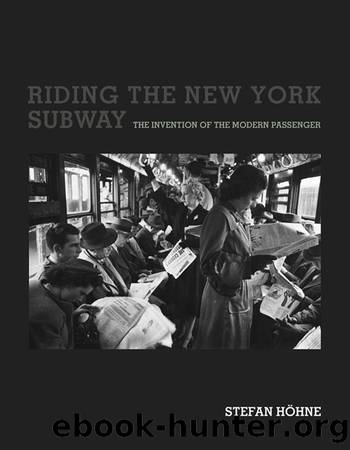Riding the New York Subway by Stefan Hohne

Author:Stefan Hohne [Höhne, Stefan]
Language: eng
Format: epub
Tags: New York City; Subway; NYC; passenger; urban; transit; subway rider; train; commuter; MTA; infrastructure; sociology; socialization; subjectivity; Foucault; urban studies; urban history; transportation history; culture
Publisher: MIT Press
Published: 2021-01-26T00:00:00+00:00
Farewell to the Machine Age
New technological developments gave people living in Western industrial nations of the 1950s the sense that they were witnessing a second industrial revolution. Heralds of this era included novel chemical methods for producing synthetic materials, and highly efficient combustion motors, along with technologies of nuclear energy, space exploration, transistors, and the first microchips. The dominant model of knowledge for the machine age, at its core an idea of the machine code, was gradually replaced by the idea of complex cybernetic systems.68 The machine age was slipping into the past, and it was time to start writing its history.
Alongside Mumford and Giedeon, architectural theorist Reyner Banham (1922â1988) saw the middle of the twentieth century as such a significant turning point that he endeavored to place the previous decades into historical perspective from the distance of only a few years. In his book Theory and Design in the First Machine Age (1960), Banham declared the beginning of a new epoch, claiming that the megastructures and large-scale technical systems of the vanishing machine age would soon be complemented by a host of miniaturized gadgets that would open up a new technological dimension of everyday life.69 This process of miniaturization would make all kinds of new conveniences possible, from radios and telephones to electric shavers and pacemakers. Banham located the greatest shift in private households. The âmachine for living inâ that Le Corbusier had envisioned in the 1920s for life in the future was steadily becoming reality for a growing portion of the population. Private households in the United States, especially, were filling up with technical novelties, from televisions and telephones to kitchen appliances, vacuum cleaners, and washing machines. As Banham dryly noted, the number of machines in the home now put more horsepower at the disposal of every housewife than an industrial worker at the turn of the century.70
Banham rightly acknowledged that many of these conveniences had been invented decades earlier, and some of them had already been enjoyed by a small portion of the population for some time already. But they were now spreading throughout society with such force that it was impossible to remain indifferent in the face of the transformation they carried with them. The shift away from large-scale technology to small machines and household gadgets also brought about a return to the human being as the measure of all things. In a certain sense, this also met Mumford and Giedionâs demands.
With all of these developments unfolding as signs of the emergence of a new era, scholars began looking for appropriate terms of description. Banham wrote of a âsecond machine age,â others suggested âlate modernityâ or âultra-modernityâ or even ânuclear age.â71 More critical voices from the Frankfurt School and some Marxist intellectuals in the United States preferred the term âlate capitalism.â72 Whatever one calls it, the period from the 1950s until the late 1970s was marked by contradictory trends and developments, especially in the United States. Following the Second World War, the United States experienced an unimagined economic boom promoted by the New Deal and Keynesianism.
Download
This site does not store any files on its server. We only index and link to content provided by other sites. Please contact the content providers to delete copyright contents if any and email us, we'll remove relevant links or contents immediately.
| Automotive | Engineering |
| Transportation |
Machine Learning at Scale with H2O by Gregory Keys | David Whiting(3611)
Never by Ken Follett(3520)
Urban Outlaw by Magnus Walker(3239)
OPNsense Beginner to Professional by Julio Cesar Bueno de Camargo(3195)
Sapiens and Homo Deus by Yuval Noah Harari(2842)
Will by Will Smith(2573)
A Short History of Nearly Everything by Bryson Bill(2505)
Hooked: A Dark, Contemporary Romance (Never After Series) by Emily McIntire(2414)
Rationality by Steven Pinker(2148)
Borders by unknow(2116)
Holy Bible (NIV) by Zondervan(2026)
The Becoming by Nora Roberts(1914)
The One Percenter Encyclopedia by Bill Hayes(1716)
Freedom by Sonny Barger(1714)
HBR's 10 Must Reads 2022 by Harvard Business Review(1696)
A Short History of War by Jeremy Black(1667)
Five Ways to Fall by K.A. Tucker(1632)
Girls Auto Clinic Glove Box Guide by Patrice Banks(1618)
Go Tell the Bees That I Am Gone by Diana Gabaldon(1598)
